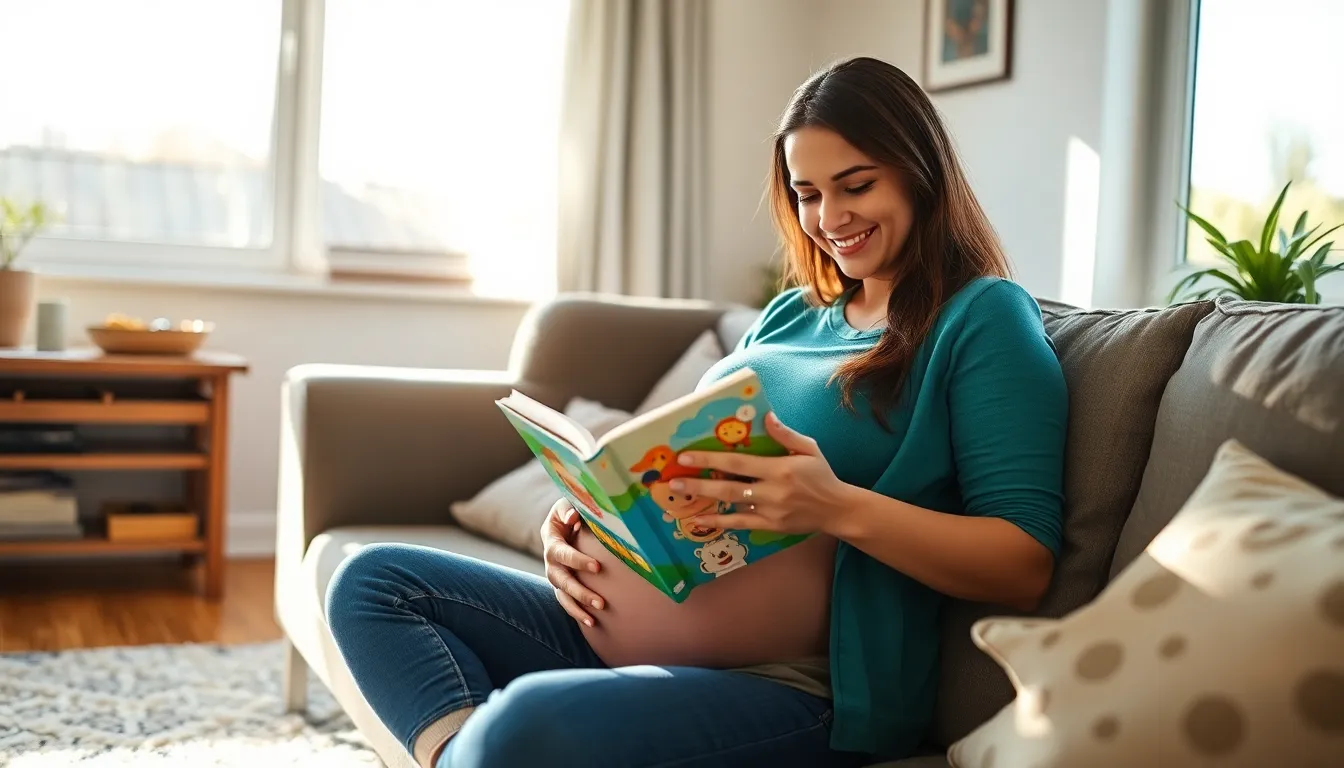Imagine cozying up with a good book, but instead of a comfy chair, you’ve got a baby bump as your audience. Sounds peculiar? It’s not just a quirky trend; it’s a delightful way to bond with your little one before they even make their grand entrance. Reading to your bump isn’t just about storytelling; it’s about creating a warm, nurturing environment that sparks early brain development and fosters a love for literature right from the start.
So, why not turn that bump into the best listener around? From classic fairy tales to silly rhymes, every word you share helps your baby become familiar with sounds and rhythms. Plus, it gives parents a chance to practice their dramatic readings—who knew a little one could inspire such Oscar-worthy performances? Dive into the whimsical world of reading to your bump and discover how this simple act can create lasting connections and joyful memories.
Table of Contents
ToggleUnderstanding the Concept of Reading to Your Bump
Reading to a baby bump offers a special way to connect with an unborn child. This activity fosters bonding and creates a nurturing environment. Engaging with stories, whether they’re classic fairy tales or playful nursery rhymes, enhances both emotional and cognitive development. Parents can introduce their baby to language patterns, rhythms, and sounds even before birth.
Studies show that exposure to language during pregnancy can positively impact early brain development. Hearing varied intonations helps babies recognize voices and sounds after birth. The benefits extend beyond just language; this practice encourages parents to develop their storytelling abilities, fostering creativity and expression.
Expecting parents can choose any book, allowing for personalization in their selections. Many favor reading simple, rhythmic stories that capture attention and resonate with little ones. Moreover, creating a routine around reading can further strengthen the bond between the parent and child.
Reading aloud not only stimulates the baby’s brain but also promotes a calming experience for the mother. It provides a moment of relaxation and joy amid the physical changes of pregnancy. Through shared stories, parents are building an emotional connection that lasts a lifetime.
Incorporating this charming tradition into daily life establishes a foundation for future reading habits. Parents instill a love for literature right from the start. This early introduction prepares children for enjoyable reading experiences after birth, solidifying the importance of storytelling in family life.
Benefits of Reading to Your Bump
Reading to a baby bump offers numerous advantages for both the expectant mother and the unborn child. This delightful practice enhances bonding while fostering essential development.
Emotional Connection
Reading aloud creates a unique emotional bond between parents and their baby. This helps unborn babies sense the loving presence of their parents. When parents express affection through stories, it nurtures security and warmth during pregnancy. Shared storytelling moments can alleviate stress, providing comfort for both mother and child. Engaging in this practice can result in strong emotional ties that may persist long after birth. Tailoring the reading experience with uplifting narratives encourages joyful interactions, further enriching the parent-child relationship.
Cognitive Development
Cognitive growth significantly benefits from reading during pregnancy. Exposure to language patterns and sounds promotes brain development as babies begin recognizing their parents’ voices. Familiarity with rhythms and tones builds a foundational understanding of language, which will ease the communication process after birth. Research reveals that auditory stimulation before birth can improve early language skills. Choosing simple, rhythmic stories enhances this effect, acting as a precursor to more complex language acquisition. As storytelling continues after birth, the groundwork laid during pregnancy serves as a stepping stone for lifelong learning.
Suggested Books for Pregnant Parents
Reading to a bump can include a variety of delightful books. Here’s a selection perfect for this charming practice.
Classic Children’s Literature
Classic children’s literature remains timeless and enchanting. “The Very Hungry Caterpillar” by Eric Carle introduces colorful illustrations and simple narratives that captivate both parents and babies. “Goodnight Moon” by Margaret Wise Brown offers rhythmic phrases creating a soothing bedtime experience. “Where the Wild Things Are” by Maurice Sendak invites imaginative journeys, promoting vivid thoughts and emotions. These stories nurture emotional connections while sharing the love of reading, setting a strong literary foundation for the child’s future.
Modern Favorites
Modern favorites bring fresh perspectives and engaging storytelling. “The Pout-Pout Fish” by Debbie Diesen features playful rhymes and vivid sea life, drawing in young listeners. “Don’t Let the Pigeon Drive the Bus!” by Mo Willems encourages interactive participation, making reading a fun and lively activity. “Ada Twist, Scientist” by Andrea Beaty sparks curiosity and promotes learning, inspiring a love for exploration and discovery. These contemporary selections balance enjoyment with education, enriching the bonding experience between parents and their unborn children.
Tips for Making Reading a Ritual
Reading to the baby bump becomes more meaningful with a consistent routine. Establishing this practice fosters connection and enriches the prenatal journey.
Creating a Cozy Environment
Create a warm and inviting space for reading sessions. Dim lights and comfortable seating enhance relaxation. Surrounding oneself with soft blankets and pillows encourages a soothing atmosphere. Incorporating calming scents, like lavender, can promote tranquility. Choosing a spot that feels special makes each reading session feel like a cherished event. Encouraging your partner to join enhances the experience, providing shared moments. Putting on soft music might add a pleasant background ambiance as you read.
Timing and Frequency
Select specific times each day for reading aloud, such as during morning coffee or before bedtime. Establishing a routine helps the unborn baby recognize familiar sounds. Reading for ten to fifteen minutes daily proves beneficial, allowing for consistent exposure to language patterns. Adjusting frequency to fit personal schedules still allows for flexibility in bonding time. Engaging with favorite stories repeatedly reinforces comfort and familiarity. Over time, these moments become treasured rituals for both parent and child.
Conclusion
Reading to a baby bump is a delightful practice that fosters a deep emotional connection between parents and their unborn child. This charming ritual not only enriches the prenatal experience but also lays the groundwork for cognitive and language development. By creating a cozy routine and selecting engaging stories, parents can introduce their little ones to the joys of literature even before birth.
The benefits extend beyond the immediate bonding experience, as consistent exposure to language helps prepare babies for communication after they arrive. Embracing this tradition can create cherished memories and strengthen ties that last a lifetime. Ultimately, reading to a bump is a meaningful way to nurture a loving environment that supports both emotional well-being and early brain development.





